Atmospheric Deposition of Benzo[a]pyrene: Developing a Spatial Pattern at a National Scale
Abstract
:1. Introduction
2. Materials and Methods
2.1. Monitoring Network
2.2. BaP Trends and Seasonal Changes
2.3. Ambient BaP Concentration Maps
2.4. BaP Deposition Flux Maps
2.5. Wet-Only BaP Deposition at the Košetice Site
3. Results
3.1. Ambient BaP Concentration Trends and Seasonal Changes
3.2. BaP Deposition Flux Maps
3.3. Comparison of Wet-Only and Dry BaP Deposition at the Košetice Site
4. Discussion
4.1. Ambient BaP Exposure in the CR in Spatial and Temporal Context
4.2. Relevance of BaP Dry Deposition for the Estimation of Total BaP Deposition Flux
4.3. Strength and Limitations of the BaP Concentration and Deposition Maps
4.3.1. Strength of Final BaP Deposition Maps
4.3.2. Uncertainties in the BaP Concentration Maps
4.3.3. Uncertainties Due to Deposition Velocity
4.4. BaP at the Košetice Site
5. Conclusions
Author Contributions
Funding
Institutional Review Board Statement
Informed Consent Statement
Data Availability Statement
Acknowledgments
Conflicts of Interest
References
- Seinfeld, J.H.; Pandis, S.N. Atmospheric Chemistry and Physics; John Wiley: New York, NY, USA, 1998; p. 1326. [Google Scholar]
- Fernández, P.; Grimalt, J.O.; Vilanova, R.M. Atmospheric Gas-Particle Partitioning of Polycyclic Aromatic Hydrocarbons in High Mountain Regions of Europe. Environ. Sci. Technol. 2002, 36, 1162–1168. [Google Scholar] [CrossRef] [PubMed]
- Callén, M.S.; de la Cruz, M.T.; López, J.M.; Murillo, R.; Navarro, M.V.; Mastral, A.M. Some inferences on the mechanism of atmospheric gas/particle partitioning of polycyclic aromatic hydrocarbons (PAH) at Zaragoza (Spain). Chemosphere 2008, 73, 1357–1365. [Google Scholar] [CrossRef] [PubMed] [Green Version]
- Eagar, J.D.; Ervens, B.; Herckes, P. Impact of partitioning and oxidative processing of PAH in fogs and clouds on atmospheric lifetimes of PAH. Atmos. Environ. 2017, 160, 132–141. [Google Scholar] [CrossRef] [Green Version]
- Nielsen, T.; Jorgensen, H.E.; Larsen, J.C.; Poulsen, M. City air pollution of polycyclic aromatic hydrocarbons and other mutagens: Occurrence, sources and health effects. Sci. Total Environ. 1996, 189–190, 41–49. [Google Scholar] [CrossRef]
- Jiménez-Guerrero, P.; Ratola, N. Influence of the North Atlantic oscillation on the atmospheric levels of benzo[a]pyrene over Europe. Clim. Dyn. 2021, 57, 1173–1186. [Google Scholar] [CrossRef]
- Masclet, P.; Mouvier, G.; Nikolaou, K. Relative decay index and sources of polycyclic aromatic hydrocarbons. Atmos. Environ. 1986, 20, 439–446. [Google Scholar] [CrossRef]
- Thomas, J.F.; Mukai, M.; Tebbens, B.D. Fate of airborne benzoapyrene. Environ. Sci. Technol. 1968, 2, 33. [Google Scholar]
- Lunde, G.; Bjorseth, A. Polycyclic aromatic hydrocarbons in long-range transported aerosols. Nature 1977, 268, 518–519. [Google Scholar] [CrossRef]
- Guerreiro, C.B.B.; Horálek, J.; de Leuw, F.; Couvidat, F. Benzo(a)pyrene in Europe: Ambient air concentrations, population exposure and health effects. Environ. Pollut. 2016, 214, 657–667. [Google Scholar] [CrossRef]
- WG PAH/Working Group on Polycyclic Aromatic Hydrocarbons. Ambient Air Pollution by Polycyclic Aromatic Hydrocarbons (PAH); Position Paper; European Community: Luxembourg, 2001; Available online: https://ec.europa.eu/environment/archives/air/pdf/pp_pah.pdf (accessed on 20 November 2021).
- EC. Directive 2004/107/EC of the European Parliament and of the Council of 15 December 2004 Relating to Arsenic, Cadmium, Mercury and Polycyclic Aromatic Hydrocarbons in Ambient Air; OJ L 23, 26.1.2005; EC: Strasbourg, France, 2004; pp. 3–16. [Google Scholar]
- Boström, C.-E.; Gerde, P.; Hanberg, A.; Jernström, B.; Johansson, C.; Kyrklund, T.; Rannug, A.; Törnqvist, M.; Victorin, K.; Westerholm, R. Cancer risk assessment, indicators and guidelines for polycyclic aromatic hydrocarbons in ambient air. Environ. Health Perspect. 2002, 110, 451–489. [Google Scholar]
- Kim, K.-H.; Jahan, S.A.; Kabir, E.; Brown, R.J.C. A review of airborne polycyclic aromatic hydrocarbons (PAHs) and their human health effects. Environ. Int. 2013, 60, 71–80. [Google Scholar] [CrossRef] [PubMed]
- EEA. Air Quality in Europe—2019 Report; EEE Report No. 10/2019; European Environment Agency: Luxembourg, 2019.
- Bidleman, T.F. Atmospheric processes—Wet and dry deposition of organic compounds are controlled by their vapor-particle partitioning. Environ. Sci. Technol. 1988, 22, 361–367. [Google Scholar] [CrossRef]
- Bieser, J.; Aulinger, A.; Matthias, V.; Quante, M. Impact of Emission Reductions between 1980 and 2020 on Atmospheric Benzo[a]pyrene Concentrations over Europe. Water Air Soil Pollut. 2012, 223, 1393–1414. [Google Scholar] [CrossRef] [Green Version]
- Cao, X.; Huo, S.; Zhang, H.; Ma, C.; Zheng, J. Seasonal variability in multimedia transport and fate of benzo[a]pyrene (BaP) affected by climatic factors. Environ. Pollut. 2022, 292, 118404. [Google Scholar] [CrossRef] [PubMed]
- Hůnová, I. Ambient Air Quality in the Czech Republic: Past and Present. Atmosphere 2020, 11, 214. [Google Scholar] [CrossRef] [Green Version]
- Schreiberová, M.; Vlasáková, L.; Vlček, O.; Šmejdířová, J.; Horálek, J.; Bieser, J. Benzo[a]pyrene in the Ambient Air in the Czech Republic: Emission Sources, Current and Long-Term Monitoring Analysis and Human Exposure. Atmosphere 2020, 11, 955. [Google Scholar] [CrossRef]
- CHMI. Air Pollution in the Czech Republic in 2020; Graphical Yearbook (Czech/English); Czech Hydrometeorological Institute: Prague, Czech Republic, 2021.
- Mann, H.B. Nonparametric tests against trend. Econometrica 1945, 13, 245–259. [Google Scholar] [CrossRef]
- Kendall, M.G. Rank Correlation Methods; Charles Gran: London, UK, 1955. [Google Scholar]
- Garrido, A.; Jimenez-Guerrero, P.; Ratola, N. Levels, trends and health concerns of atmospheric PAHs in Europe. Atmos. Environ. 2014, 99, 474–484. [Google Scholar] [CrossRef]
- Albuquerquea, M.; Coutinho, M.; Borrego, C. Long-term monitoring and seasonal analysis of polycyclic aromatic hydrocarbons (PAHs) measured over a decade in the ambient air of Porto, Portugal. Sci. Total Environ. 2016, 543, 439–448. [Google Scholar] [CrossRef]
- Barzeghara, V.; Sarbakhshc, P.; Hassanvandd, M.S.; Faridie, S.; Gholampoura, A. Long-term trend of ambient air PM10, PM2.5, and O3 and their health effects in Tabriz city, Iran, during 2006–2017. Sustain. Cities Soc. 2020, 54, 101988. [Google Scholar] [CrossRef]
- Hůnová, I.; Bäumelt, V.; Modlík, M. Long-term trends in nitrogen oxides at different types of monitoring stations in the Czech Republic. Sci. Total Environ. 2020, 699, 134378. [Google Scholar] [CrossRef] [PubMed]
- De Leeuw, F.A.A.M. Trends in ground level ozone concentrations in the European Union. Environ. Sci. Policy 2000, 3, 189–199. [Google Scholar] [CrossRef]
- Gilbert, R.O. Statistical Methods for Environmental Pollution Monitoring; Van Nostrand Reinhold: New York, NY, USA, 1987. [Google Scholar]
- R Core Team. R: A Language and Environment for Statistical Computing; R Foundation for Statistical Computing: Vienna, Austria, 2019; Available online: www.R-project.org (accessed on 24 November 2020).
- ETC/ACC. Spatial Mapping of Air Quality for European Scale Assessment. ETC/ACC Technical Paper 2006/6. 2007. Available online: https://www.eionet.europa.eu/etcs/etc-atni/products/etc-atni-reports/etcacc_technpaper_2006_6_spat_aq (accessed on 19 May 2020).
- CHMI. Air Pollution in the Czech Republic in 2012; Graphical Yearbook (Czech/English); Czech Hydrometeorological Institute: Prague, Czech Republic, 2013.
- CHMI. Air Pollution in the Czech Republic in 2015; Graphical Yearbook (Czech/English); Czech Hydrometeorological Institute: Prague, Czech Republic, 2016.
- CHMI. Air Pollution in the Czech Republic in 2019; Graphical Yearbook (Czech/English); Czech Hydrometeorological Institute: Prague, Czech Republic, 2020.
- Cressie, N. Statistics for Spatial Data; Wiley: New York, NY, USA, 1993. [Google Scholar]
- EMEP/MSC-E: Database on Modelling Results of HMs and POPs (1990–2017). Available online: http://en.msceast.org/index.php/pollution-assessment/emep-domain-menu?id=119 (accessed on 3 July 2020).
- Gusev, A.; Mantseva, L.; Shatalov, V.; Strukov, B. Regional Multicompartment Model MSCE-POP; EMEP/MSC-E Technical Report 5/2005; Meteorological Synthesizing Centre-East: Moscow, Russia, 2005. [Google Scholar]
- Gusev, A.; Ilyin, I.; Mantseva, L.; Rozovskaya, O.; Shatalov, V.; Travnikov, O. Progress in Further Developments of MSCE-HM and MSCE_POP Models; EMEP/MSC-E Technical Report 4/2006; Meteorological Synthesizing Centre-East: Moscow, Russia, 2006. [Google Scholar]
- CHMI. Czech Reference Dispersion Model SYMOS’97 (in Czech Only). 2020. Available online: http://portal.chmi.cz/aktualni-situace/stav-ovzdusi/modelovani-kvality-ovzdusi/model-symos (accessed on 30 April 2020).
- CAMx User´s Guide, Version 7.10. Available online: https://camx-wp.azurewebsites.net/Files/CAMxUsersGuide_v7.10.pdf (accessed on 12 December 2021).
- ETC/ATNI. Benzo(a)pyrene (BaP) Annual Mapping. Evaluation of Its Potential Regular Updating. ETC/ATNI Report 18/2021 2022. 2022. Available online: https://doi.org/10.5281/zenodo.5898376 (accessed on 8 February 2022). [CrossRef]
- Gusev, A. (Meteorological Synthesizing Centre—East, Moscow, Russia). Personal communication, 2020. [Google Scholar]
- Váňa, M.; Holubová Smejkalová, A.; Svobodová, J.; Machálek, P. Long-Term Trends of Air Pollution at National Atmospheric Observatory Košetice (ACTRIS, EMEP, GAW). Atmosphere 2020, 11, 537. [Google Scholar] [CrossRef]
- Lhotka, R.; Pokorná, P.; Zíková, N. Long-Term Trends in PAH Concentrations and Sources at Rural Background Site in Central Europe. Atmosphere 2019, 10, 687. [Google Scholar] [CrossRef] [Green Version]
- Křůmal, K.; Mikuška, P.; Horák, J.; Hopan, F.; Krpec, K. Comparison of emissions of gaseous and particulate pollutants from the combustion of biomass and coal in modern and old-type boilers used for residential heating in the Czech Republic, Central Europe. Chemosphere 2019, 229, 51–59. [Google Scholar] [CrossRef]
- Mikuška, P.; Křůmal, K.; Večeřa, Z. Characterization of organic compounds in the PM2.5 aerosol in winter in an industrial urban area. Atmos. Environ. 2015, 105, 97–108. [Google Scholar] [CrossRef]
- Vossler, T.; Cernikovsky, L.; Novak, J.; Placha, H.; Krejci, B.; Nikolova, I.; Chalupnickova, E.; Williams, R. An investigation of local and regional sources of fine particulate matter in Ostrava, the Czech Republic. Atmos. Pollut. Res. 2015, 6, 454–463. [Google Scholar]
- Pokorná, P.; Hovorka, J.; Klán, M.; Hopke, P.K. Source apportionment of size resolved particulate matter at a European air pollution hot spot. Sci. Total Environ. 2015, 502, 172–183. [Google Scholar] [CrossRef]
- Horak, J.; Kubonova, L.; Krpec, K.; Hopan, F.; Kubesa, P.; Motyka, O.; Laciok, V.; Dej, M.; Ochodek, T.; Placha, D. PAH emissions from old and new types of domestic hot water boilers. Environ. Pollut. 2017, 225, 31–39. [Google Scholar] [CrossRef]
- Kozáková, J.; Pokorná, P.; Vodička, P.; Ondráčková, L.; Ondráček, J.; Křůmal, K.; Mikuška, P.; Hovorka, J.; Moravec, P.; Schwarz, J. The influence of local emissions and regional air pollution transport on a European air pollution hot spot. Environ. Sci. Pollut. Res. 2019, 26, 1675–1692. [Google Scholar] [CrossRef]
- Łupikasza, E.B.; Niedźwiedź, T. Relationships between Vertical Temperature Gradients and PM10 Concentrations during Selected Weather Conditions in Upper Silesia (Southern Poland). Atmosphere 2022, 13, 125. [Google Scholar] [CrossRef]
- Volná, V.; Hladký, D.; Seibert, R.; Krejčí, B. Transboundary Air Pollution Transport of PM10 and Benzo[a]pyrene in the Czech–Polish Border Region. Atmosphere 2022, 13, 341. [Google Scholar] [CrossRef]
- Tham, Y.W.F.; Takeda, K.; Sakugawa, H. Polycyclic aromatic hydrocarbons (PAHs) associated with atmospheric particles in Higashi Hiroshima, Japan: Influence of meteorological conditions and seasonal variations. Atmos. Res. 2008, 88, 224–233. [Google Scholar] [CrossRef]
- Masiol, M.; Hofer, A.; Squizzato, S.; Piazza, R.; Rampazzo, G.; Pavoni, B. Carcinogenic and mutagenic risk associated to airborne particle-phase polycyclic aromatic hydrocarbons: A source apportionment. Atmos. Environ. 2012, 60, 375–382. [Google Scholar] [CrossRef]
- Gianelle, V.; Colombi, C.; Caserini, S.; Ozgen, S.; Galante, S.; Marongiu, A.; Lanzani, G. Benzo(a)pyrene air concentrations and emission inventory in Lombardy region, Italy. Atmos. Pollut. Res. 2013, 4, 257–266. [Google Scholar] [CrossRef] [Green Version]
- Liu, Y.; Tao, S.; Yang, Y.; Dou, H.; Yang, Y.; Coveney, R.M. Inhalation exposure of traffic police officers to polycyclic aromatic hydrocarbons (PAHs) during the winter in Beijing, China. Sci. Total Environ. 2007, 383, 98–105. [Google Scholar] [CrossRef]
- Li, Z.; Porter, E.N.; Sjodin, A.; Larry, L.; Need-Ham, L. Characterization of PM2.5 bound polycyclic aromatic hydrocarbons in Atlanta. Seasonal vari-ations at urban, suburban, and rural ambient air monitoring sites. Atmos. Environ. 2009, 49, 4187–4193. [Google Scholar] [CrossRef]
- Ludykar, D.; Westerholm, R.; Almen, J. Cold start emissions at +22, −7 and −20 degrees C ambient temperatures from a three-way catalyst (TWC) car: Regulated and unregulated exhaust components. Sci. Total Environ. 1999, 235, 65–69. [Google Scholar] [CrossRef]
- Teixeira, E.C.; Agudelo-Castañeda, D.M.; Fachel, J.M.G.; Leal, K.A.; de Oliveira Garcia, K.; Wiegand, F. Source identification and seasonal variation of polycyclic aromatic hydrocarbons associated with atmospheric fine and coarse particles in the Metropolitan Area of Porto Alegre, RS, Brazil. Atmos. Res. 2012, 118, 390–403. [Google Scholar] [CrossRef]
- Keyte, I.J.; Harrison, R.M.; Lammel, G. Chemical reactivity and long-range transport potential of polycyclic aromatic hydrocarbons—A review. Chem. Soc. Rev. 2013, 42, 9333. [Google Scholar] [CrossRef]
- Hůnová, I.; Bäumelt, V. Observation-based trends in ambient ozone in the Czech Republic over the past two decades. Atmos. Environ. 2018, 172, 157–167. [Google Scholar] [CrossRef]
- Hůnová, I.; Brabec, M.; Malý, M. Trends in ambient O3 concentrations at twelve sites in the Czech Republic over the past three decades: Close inspection of development. Sci. Total Environ. 2020, 746, 141038. [Google Scholar] [CrossRef] [PubMed]
- Škrdlíková, L.; Landlová, L.; Klánová, J.; Lammel, G. Wet deposition and scavenging efficiency of gaseous and particulate phase polycyclic aromatic compounds at a central European suburban site. Atmos. Environ. 2011, 45, 4305–4312. [Google Scholar] [CrossRef]
- Gocht, T.; Klemm, O.; Grathwol, P. Long-term atmospheric bulk deposition of polycyclic aromatic hydrocarbons (PAHs) in rural areas of Southern Germany. Atmos. Environ. 2007, 41, 1315–1327. [Google Scholar] [CrossRef]
- Kiss, G.; Varga-Puchony, Z.; Tolnai, B.; Varga, B.; Gelencsér, A.; Krivácsy, Z.; Hlavay, J. The seasonal changes in the concentration of polycyclic aromatic hydrocarbons in precipitation and aerosol near Lake Balaton, Hungary. Environ. Pollut. 2001, 114, 55–61. [Google Scholar] [CrossRef]
- Siudek, P.; Ruczynska, W. Simultaneous Measurements of PM2.5- and PM10-bound Benzo(a)pyrene in a Coastal Urban Atmosphere in Poland: Seasonality of Dry Deposition Fluxes and Influence of Atmospheric Transport. Aerosol Air Qual. Res. 2021, 21, 210044. [Google Scholar] [CrossRef]
- Wang, Q.; Liu, M.; Yu, Y.; Li, Y. Characterization and source apportionment of PM2.5-bound polycyclic aromatic hydrocarbons from Shanghai city, China. Environ. Pollut. 2016, 218, 118–128. [Google Scholar] [CrossRef]
- Van Jaarsveld, J.A.; van Pul, W.A.J.; de Leeuw, F.A.A.M. Modelling transport and deposition of persistent organic pollutants in the European region. Atmos. Environ. 1997, 31, 1011–1024. [Google Scholar] [CrossRef]
- EC. Council Decision 97/101/EC of 27 January 1997 Establishing a Reciprocal Exchange of Information and Data from Networks and Individual Stations Measuring Ambient Air Pollution within the Member States; OJEC L 35/14; EC: Brussels, Belgium, 1997. [Google Scholar]
- Brook, J.R.; Di-Giovanni, F.; Cakmak, S.; Meyers, T.P. Estimation of dry deposition velocity using inferential models and site-specific meteorology—Uncertainty due to siting of meteorological towers. Atmos. Environ. 1997, 31, 3911–3919. [Google Scholar] [CrossRef]
- Terzi, E.; Samara, C. Dry deposition of polycyclic aromatic hydrocarbons in urban and rural sites of Western Greece. Atmos. Environ. 2005, 39, 6261–6270. [Google Scholar] [CrossRef]
- Esen, F.; Cindoruk, S.; Tasdemir, Y. Bulk deposition of polycyclic aromatic hydrocarbons (PAHs) in an industrial site of Turkey. Environ. Pollut. 2008, 152, 461–467. [Google Scholar] [CrossRef] [PubMed]
- He, Q.; Zhang, L.; Cui, Y.; Cheng, M.; Guo, L.; Liu, M.; Chen, L. Particle dry deposition of polycyclic aromatic hydrocarbons and its risk assessment in a typical coal-polluted and basin city, northern China. Atmos. Pollut. Res. 2017, 8, 1081–1089. [Google Scholar] [CrossRef]
- Feng, G.-C.; Chang, K.F.; Lu, C.; Bai, H. Estimation of PAHs dry deposition and BaP toxic equivalency factors (TEFs) study at Urban, Industry Park and rural sampling sites in central Taiwan, Taichung. Chemosphere 2004, 55, 787–796. [Google Scholar] [CrossRef] [PubMed]
- Liu, J.; Jia, J.; Grathwohl, P. Dilution of concentrations of PAHs from atmospheric particles, bulk deposition to soil: A review. Environ. Geochem. Health 2022. [Google Scholar] [CrossRef]
- Chang, K.-F.; Fang, G.-C.; Lu, C.; Bai, H. Estimating PAH Dry Deposition by Measuring Gas and Particle Phase Concentrations in Ambient Air. Aerosol Air Qual. Res. 2003, 3, 41–51. [Google Scholar] [CrossRef] [Green Version]
- Nežiková, B.; Degrendele, C.; Čupr, P.; Hohenblum, P.; Moche, W.; Prokeš, R.; Vaňková, L.; Kukučka, P.; Martiník, J.; Audy, O.; et al. Bulk atmospheric deposition of persistent organic pollutants and polycyclic aromatic hydrocarbons in Central Europe. Environ. Sci. Pollut. Res. 2019, 26, 23429–23441. [Google Scholar] [CrossRef] [Green Version]
- Liu, L.-Y.; Kukučka, P.; Venier, M.; Salamova, A.; Klánová, J.; Hites, R.A. Differences in spatiotemporal variations of atmospheric PAH levels between North America and Europe: Data from two air monitoring projects. Environ. Int. 2014, 64, 48–55. [Google Scholar] [CrossRef]
- Settimo, G.; Soggiu, M.E.; Inglessis, M.; Marsili, G.; Avino, P. Persistent Organic Pollutants and Metals in Atmospheric Deposition Rates around the Port-Industrial Area of Civitavecchia, Italy. Appl. Sci. 2021, 11, 1827. [Google Scholar] [CrossRef]
- McVeety, B.D.; Hites, R.A. Atmospheric deposition of polycyclic aromatic hydrocarbons to water surfaces: A mass balance approach. Atmos. Environ. 1988, 22, 511–536. [Google Scholar] [CrossRef]
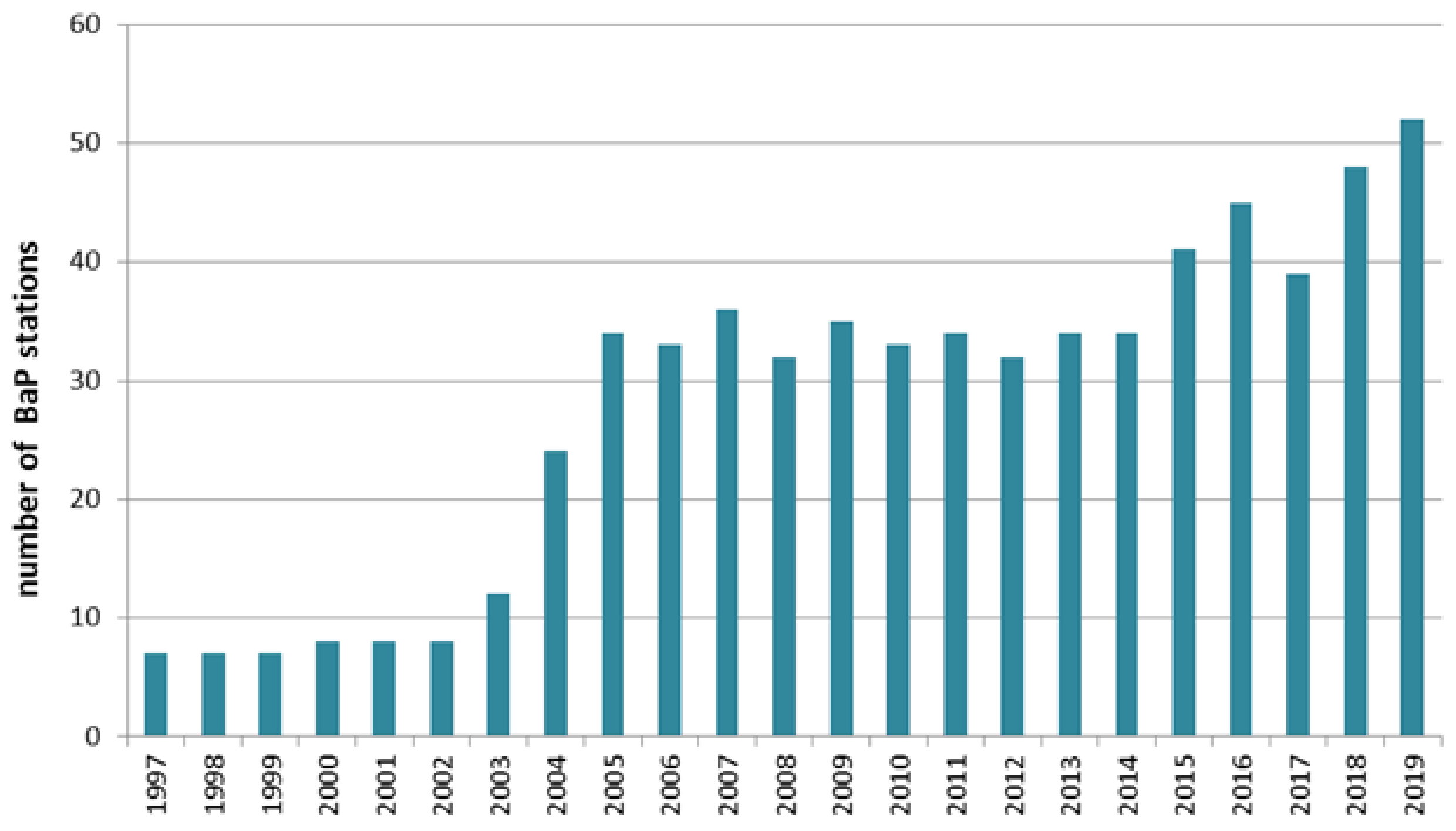
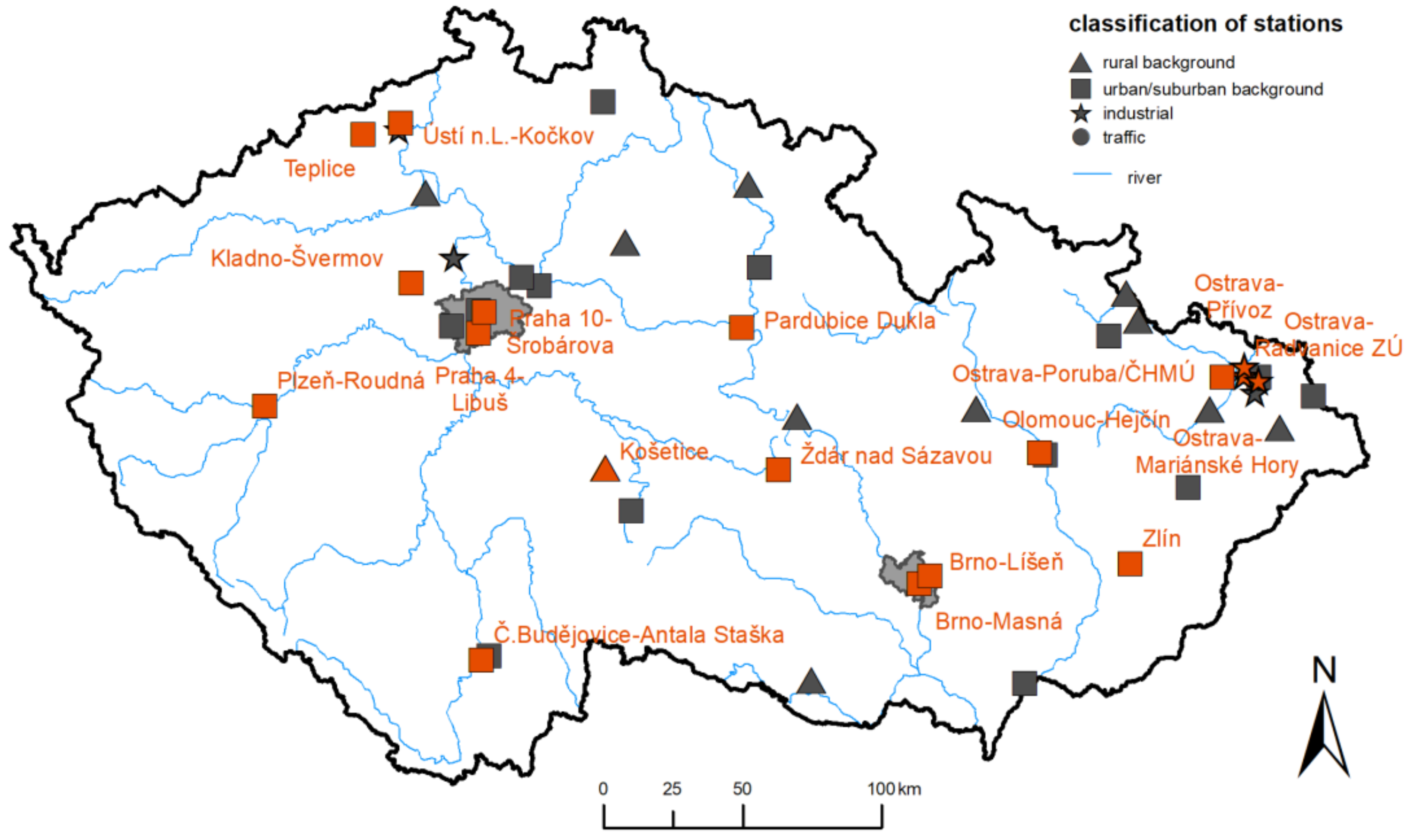
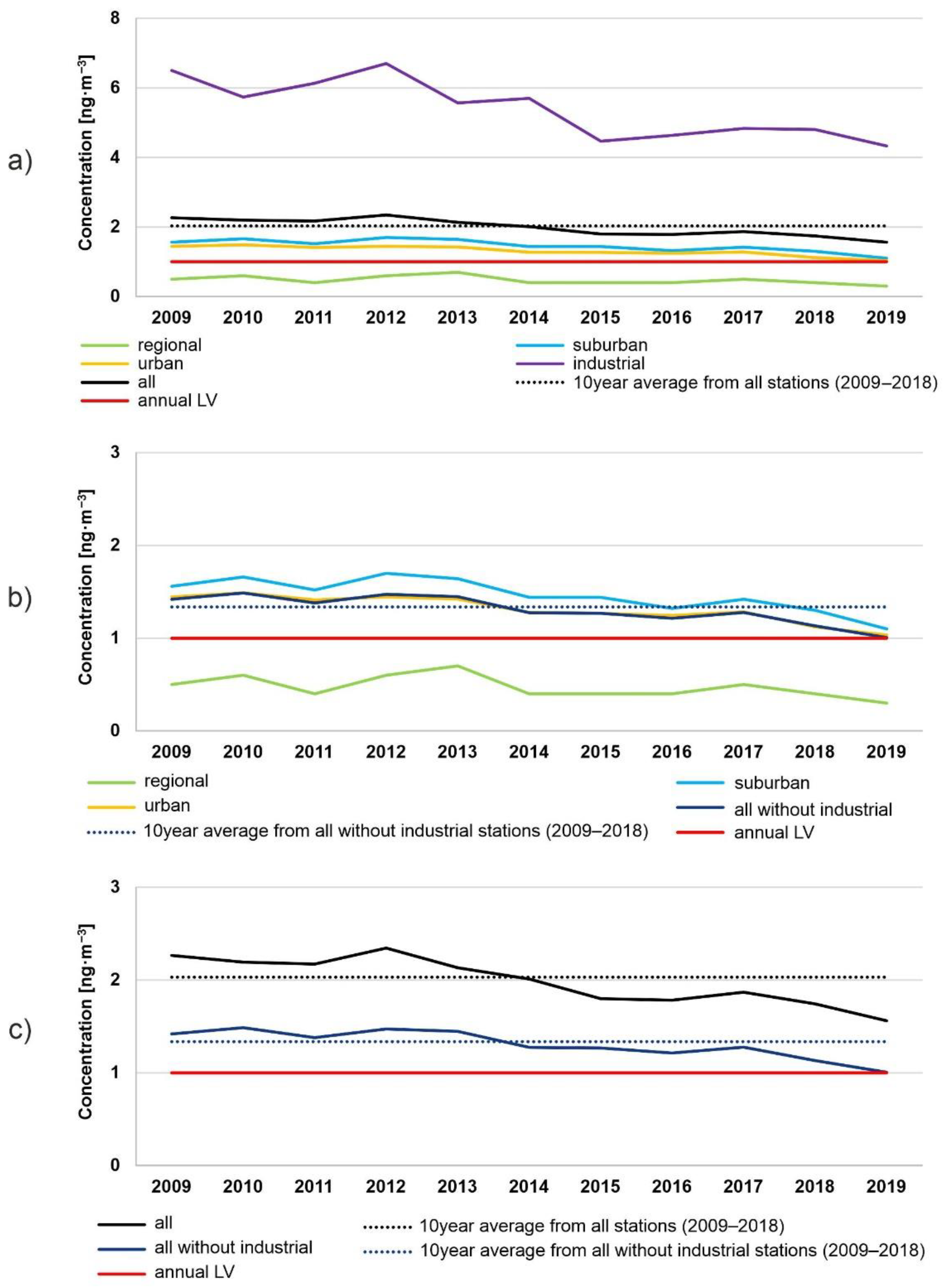

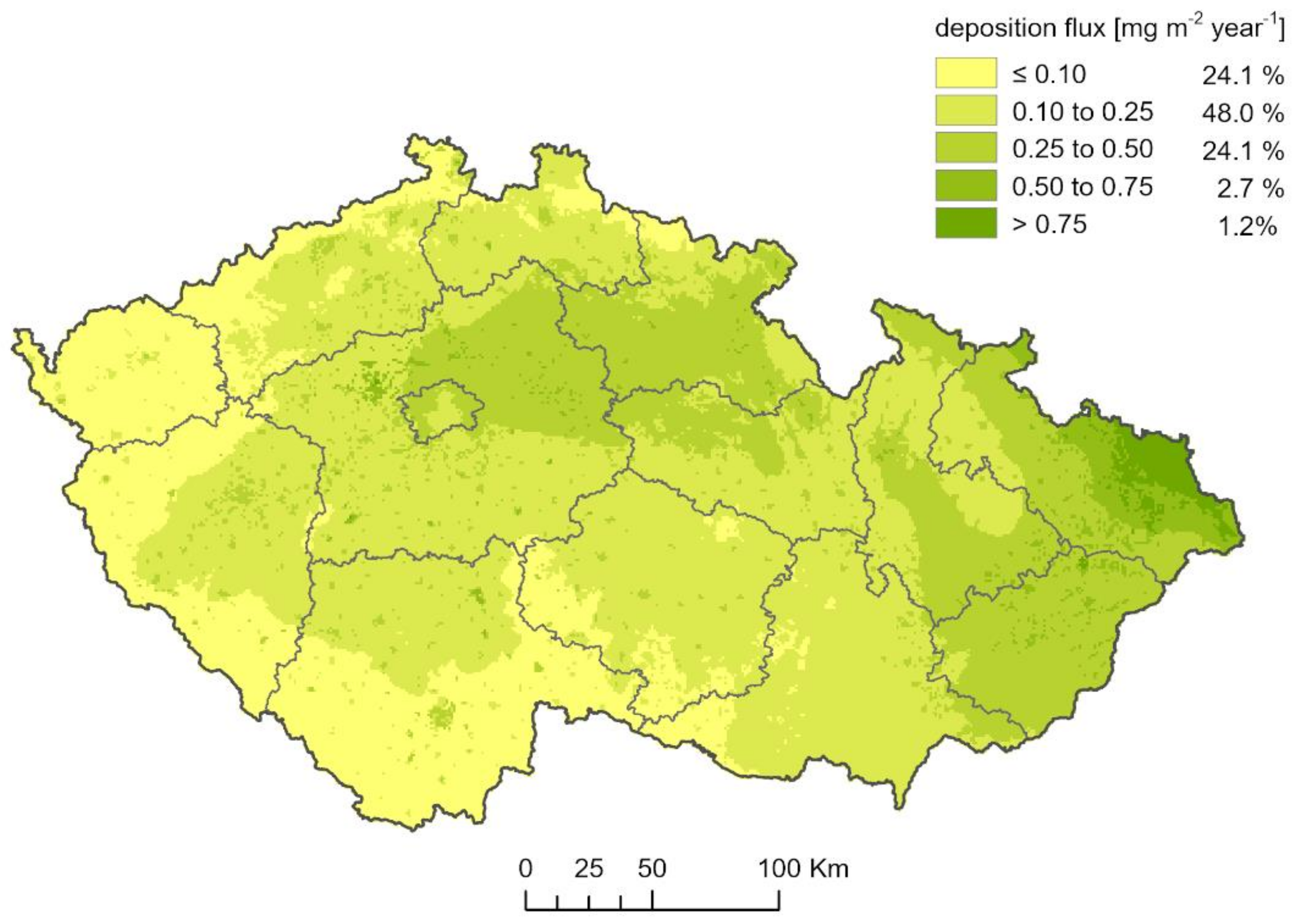
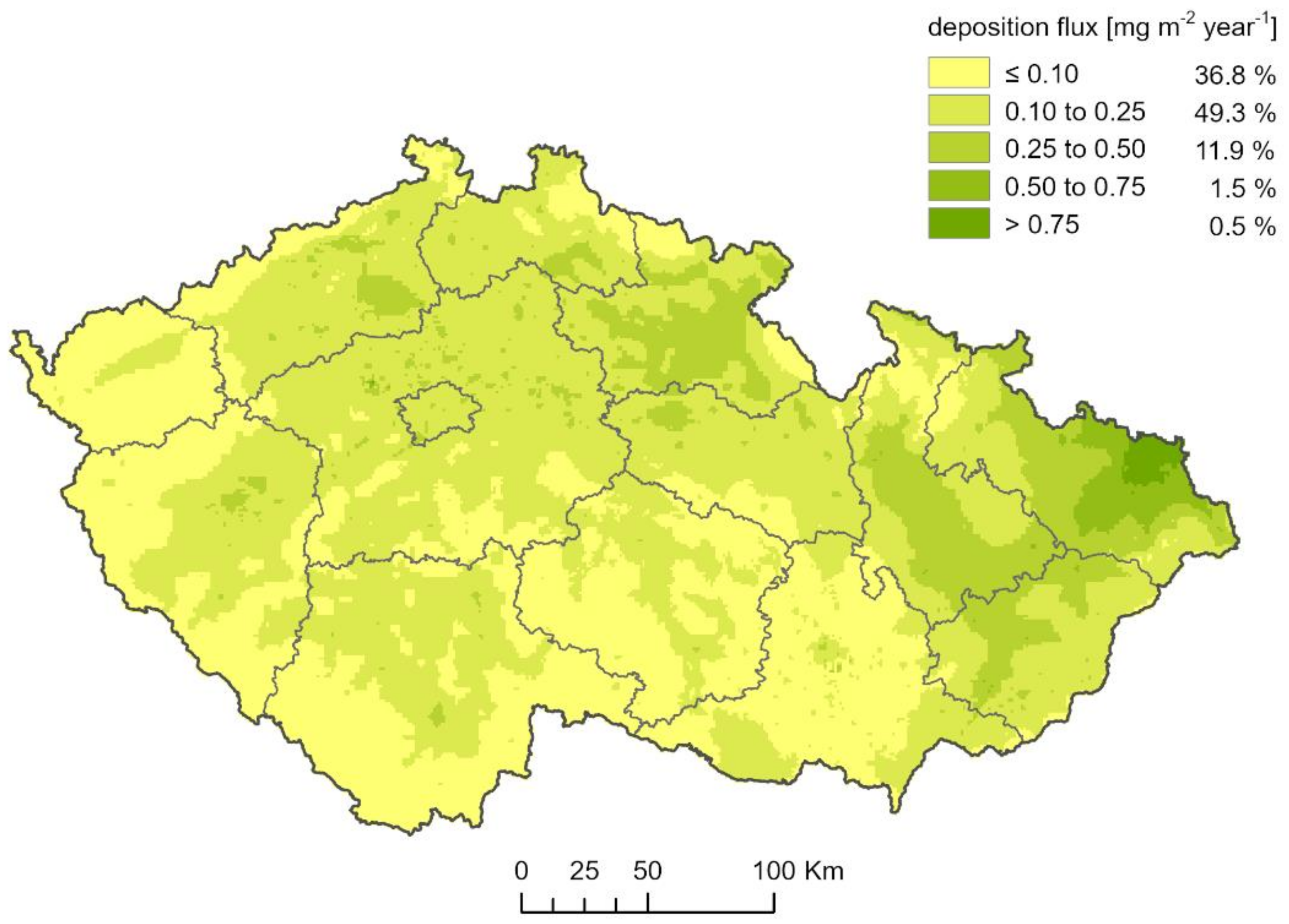
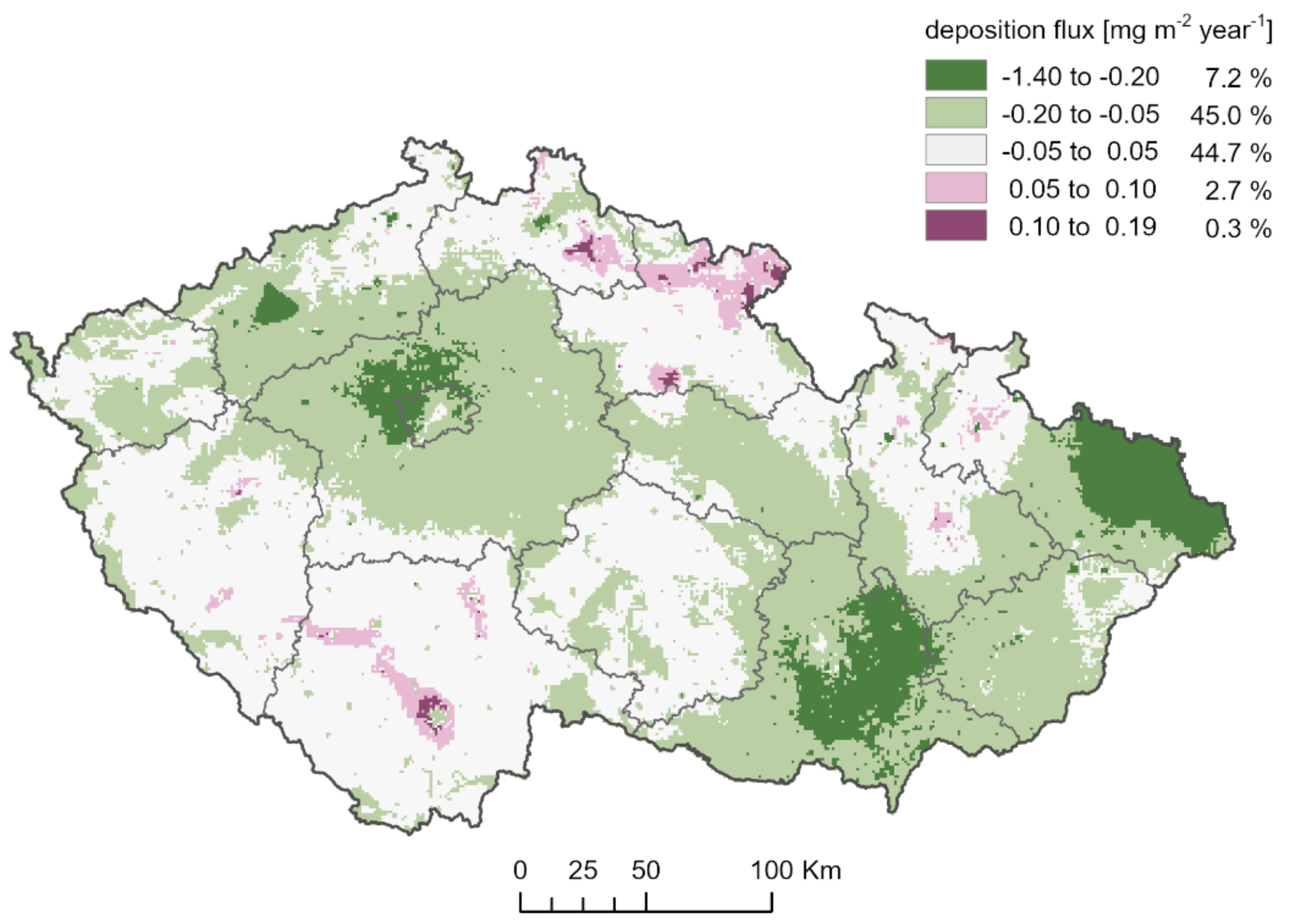
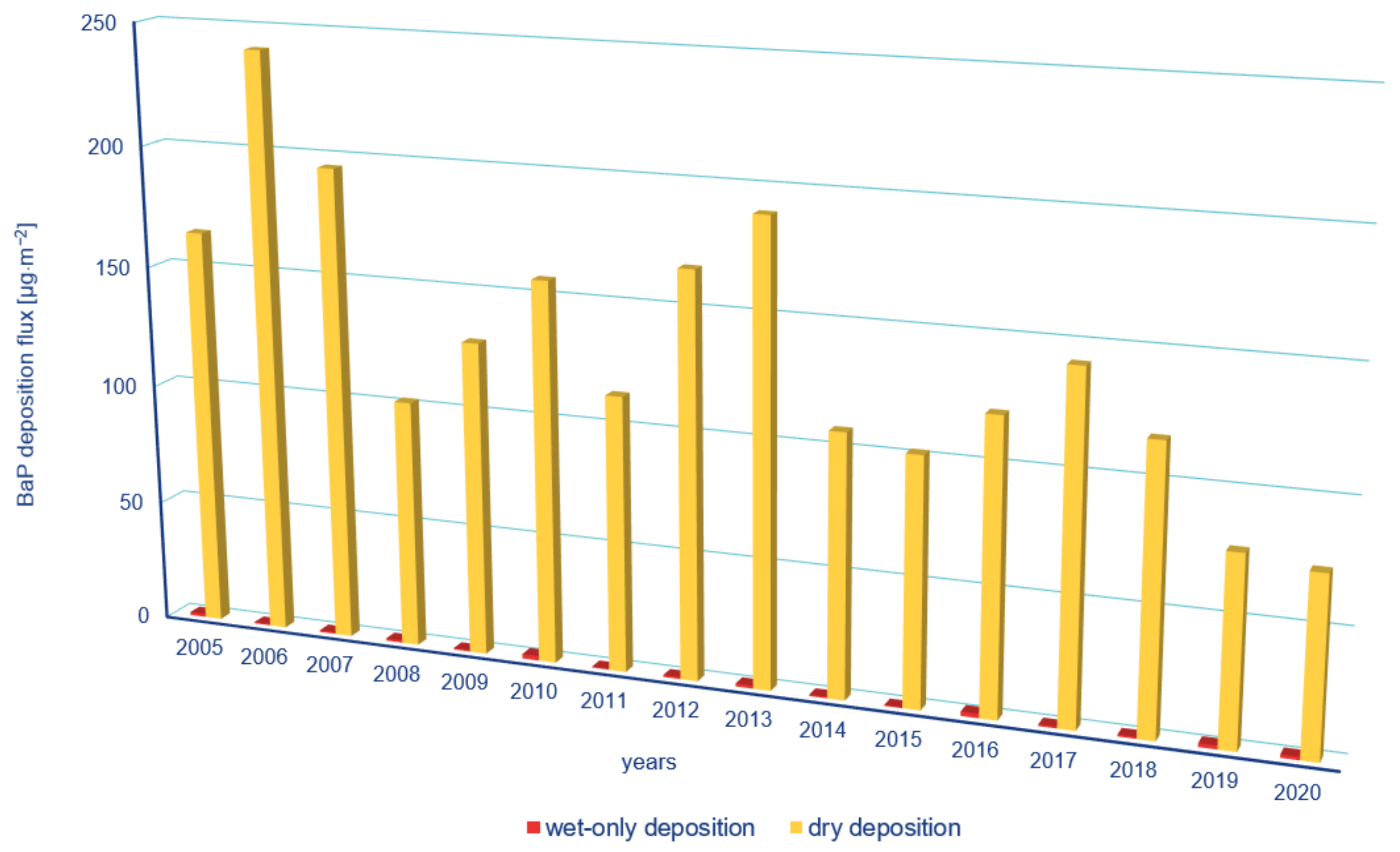
| Type of Station | 2009 | 2010 | 2011 | 2012 | 2013 | 2014 | 2015 | 2016 | 2017 | 2018 | 2019 | Mann–Kendall (Tau) | Sen’s Slope [ng·m−3 year−1] | p-Value |
|---|---|---|---|---|---|---|---|---|---|---|---|---|---|---|
| Annual Average BaP Concentration [ng·m−3] | ||||||||||||||
| regional | 0.5 | 0.6 | 0.4 | 0.6 | 0.7 | 0.4 | 0.4 | 0.4 | 0.5 | 0.4 | 0.3 | −0.43 | 0.0983 | |
| suburban | 1.6 | 1.7 | 1.5 | 1.7 | 1.6 | 1.4 | 1.4 | 1.3 | 1.4 | 1.3 | 1.1 | −0.73 | −0.05 | 0.0025 |
| urban | 1.4 | 1.5 | 1.4 | 1.4 | 1.4 | 1.3 | 1.3 | 1.2 | 1.3 | 1.1 | 1.0 | −0.84 | −0.04 | 0.0009 |
| industrial | 6.5 | 5.7 | 6.1 | 6.7 | 5.6 | 5.7 | 4.5 | 4.6 | 4.8 | 4.8 | 4.3 | −0.61 | −0.22 | 0.0122 |
| all | 2.3 | 2.2 | 2.2 | 2.3 | 2.1 | 2.0 | 1.8 | 1.8 | 1.9 | 1.7 | 1.6 | −0.82 | −0.07 | 0.0007 |
| Winter (October-March) Average BaP Concentration[ng·m−3] | ||||||||||||||
| regional | 0.8 | 1.0 | 0.7 | 1.1 | 1.2 | 0.7 | 0.6 | 0.8 | 0.9 | 0.8 | 0.4 | −0.25 | 0.3433 | |
| suburban | 2.8 | 3.2 | 2.8 | 3.3 | 2.9 | 2.6 | 2.5 | 2.3 | 2.6 | 2.3 | 1.9 | −0.67 | −0.10 | 0.0060 |
| urban | 2.9 | 2.9 | 2.8 | 2.9 | 2.8 | 2.5 | 2.2 | 2.2 | 2.4 | 2.0 | 1.8 | −0.84 | −0.11 | 0.0007 |
| industrial | 10.5 | 10.2 | 9.7 | 10.6 | 8.5 | 8.7 | 7.1 | 7.1 | 7.5 | 8.0 | 6.6 | −0.66 | −0.39 | 0.0063 |
| all | 3.7 | 3.8 | 3.6 | 3.9 | 3.4 | 3.2 | 3.0 | 2.9 | 3.3 | 3.0 | 2.5 | −0.70 | −0.13 | 0.0039 |
| Summer (April-September) Average BaP Concentration[ng·m−3] | ||||||||||||||
| regional | 0.1 | 0.1 | 0.1 | 0.1 | 0.2 | 0.1 | 0.1 | 0.1 | 0.1 | 0.1 | 0.1 | −0.09 | 0.8744 | |
| suburban | 0.3 | 0.3 | 0.2 | 0.3 | 0.5 | 0.3 | 0.3 | 0.3 | 0.3 | 0.2 | 0.3 | −0.11 | 0.7626 | |
| urban | 0.2 | 0.3 | 0.2 | 0.3 | 0.4 | 0.3 | 0.2 | 0.3 | 0.2 | 0.2 | 0.2 | −0.23 | 0.4263 | |
| industrial | 2.1 | 1.4 | 1.7 | 1.6 | 1.9 | 2.0 | 1.8 | 2.1 | 2.2 | 1.7 | 2.0 | 0.30 | 0.2386 | |
| all | 0.5 | 0.4 | 0.4 | 0.5 | 0.6 | 0.5 | 0.5 | 0.6 | 0.6 | 0.4 | 0.5 | 0.24 | 0.3997 | |
| Years | (ng·m−3) | ||||
|---|---|---|---|---|---|
| ≤0.4 | 0.4–0.6> | 0.6–1.0> | 1.0–2.0> | >2.0 | |
| (%) | |||||
| 2012 | 25.5 | 18.8 | 29.2 | 23.8 | 2.7 |
| 2013 | 12.1 | 26.3 | 44.3 | 15.2 | 2.1 |
| 2014 | 29.8 | 29.0 | 30.5 | 9.0 | 1.7 |
| 2015 | 28.3 | 24.9 | 26.4 | 17.5 | 2.9 |
| 2016 | 25.0 | 19.0 | 30.1 | 23.1 | 2.8 |
| 2017 | 25.8 | 20.3 | 27.9 | 23.0 | 3.0 |
| 2018 | 41.2 | 15.7 | 30.5 | 9.9 | 2.7 |
| 2019 | 50.6 | 17.5 | 23.5 | 7.1 | 1.3 |
Publisher’s Note: MDPI stays neutral with regard to jurisdictional claims in published maps and institutional affiliations. |
© 2022 by the authors. Licensee MDPI, Basel, Switzerland. This article is an open access article distributed under the terms and conditions of the Creative Commons Attribution (CC BY) license (https://creativecommons.org/licenses/by/4.0/).
Share and Cite
Hůnová, I.; Kurfürst, P.; Vlasáková, L.; Schreiberová, M.; Škáchová, H. Atmospheric Deposition of Benzo[a]pyrene: Developing a Spatial Pattern at a National Scale. Atmosphere 2022, 13, 712. https://doi.org/10.3390/atmos13050712
Hůnová I, Kurfürst P, Vlasáková L, Schreiberová M, Škáchová H. Atmospheric Deposition of Benzo[a]pyrene: Developing a Spatial Pattern at a National Scale. Atmosphere. 2022; 13(5):712. https://doi.org/10.3390/atmos13050712
Chicago/Turabian StyleHůnová, Iva, Pavel Kurfürst, Leona Vlasáková, Markéta Schreiberová, and Hana Škáchová. 2022. "Atmospheric Deposition of Benzo[a]pyrene: Developing a Spatial Pattern at a National Scale" Atmosphere 13, no. 5: 712. https://doi.org/10.3390/atmos13050712
APA StyleHůnová, I., Kurfürst, P., Vlasáková, L., Schreiberová, M., & Škáchová, H. (2022). Atmospheric Deposition of Benzo[a]pyrene: Developing a Spatial Pattern at a National Scale. Atmosphere, 13(5), 712. https://doi.org/10.3390/atmos13050712







